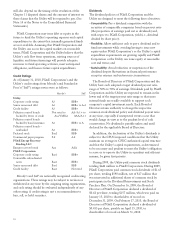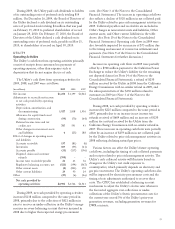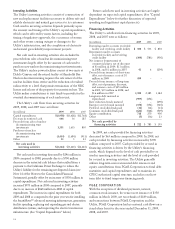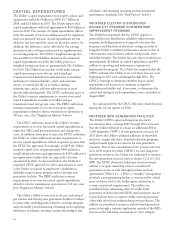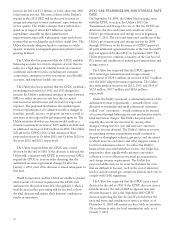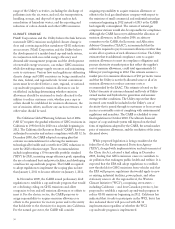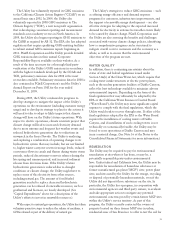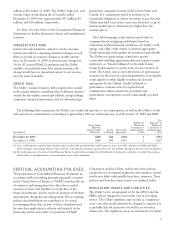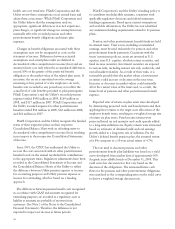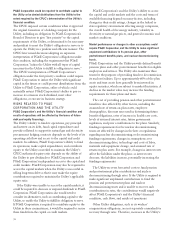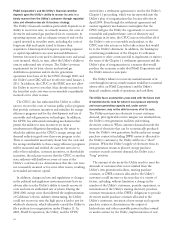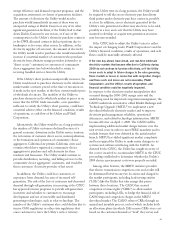PG&E 2009 Annual Report Download - page 35
Download and view the complete annual report
Please find page 35 of the 2009 PG&E annual report below. You can navigate through the pages in the report by either clicking on the pages listed below, or by using the keyword search tool below to find specific information within the annual report.The Utility has voluntarily reported its GHG emissions
to the California Climate Action Registry (“CCAR”) on an
annual basis since 2002. In 2009, the Utility also
voluntarily reported its 2008 GHG emissions to The
Climate Registry (“TCR”), a new non-profit organization
that is developing consistent reporting and measurement
standards across industry sectors in North America. In
2009, the Utility also began reporting its GHG emissions to
the CARB as required by AB 32. The EPA also has adopted
regulations that require qualifying GHG-emitting facilities
to submit annual GHG emissions reports beginning in
2011. PG&E Corporation and the Utility provide detailed
GHG emissions data in their annual Corporate
Responsibility Report, available on their websites. As a
result of the time necessary for a thorough third-party
verification of the Utility’s GHG emissions in accordance
with the highest standards developed by the CCAR and
TCR, preliminary emissions data for 2008 is the most
recent data available. Preliminary emissions data for 2008 is
also contained in PG&E Corporation’s and the Utility’s
Annual Report on Form 10-K for the year ended
December 31, 2009.
During 2009, the Utility continued its programs to
develop strategies to mitigate the impact of the Utility’s
operations on the environment (including customer energy
usage) and to develop its strategy to plan for the actions it
will need to take to adapt to likely impacts that climate
change will have on the Utility’s future operations. With
respect to electric operations, climate scientists project that
climate change will lead to increased electricity demand
due to more extreme and frequent hot weather events and
reduced hydroelectric generation due to reductions in
snowpack in the Sierra Nevada. The Utility is analyzing
and exploring a combination of operating changes to its
hydroelectric system that may include, but are not limited
to, higher winter carryover reservoir storage levels, reduced
conveyance flows in canals and flumes during winter storm
periods, reduced discretionary reservoir releases during the
late spring and summer period, and increased sediment
releases from diversion dams. If the Utility’s future
hydroelectric generation is reduced due to drought
conditions or climate change, the Utility might have to
replace some of this electricity from other sources,
including natural gas. The amount of fossil-fueled
generation needed to replace decreased hydroelectric
generation can be reduced if renewable resources, such as
geothermal and biomass, are timely developed. (See
“Capital Expenditures” above for a description of the
Utility’s efforts to invest in renewable resources.)
With respect to natural gas operations, the Utility has taken
voluntary proactive steps to reduce the release of methane, a
GHG released as part of the delivery of natural gas.
The Utility’s strategies to reduce GHG emissions — such
as offering energy efficiency and demand response
programs for customers, infrastructure improvements, and
the support of renewable energy development — are also
effective strategies for adapting to the expected increased
demand for electricity in extreme hot weather events likely
to be caused by climate change. PG&E Corporation and
the Utility are also assessing the benefits and challenges
associated with various climate change policies, identifying
how a comprehensive program can be structured to
mitigate overall costs to customers and the economy as a
whole, as well as to ensure that the environmental
objectives of the program are met.
WATER QUALITY
In addition, there is continuing uncertainty about the
status of state and federal regulations issued under
Section 316(b) of the Clean Water Act, which require that
cooling water intake structures at electric power plants,
such as the nuclear generation facilities at Diablo Canyon,
reflect the best technology available to minimize adverse
environmental impacts. Depending on the form of the
final regulations that may ultimately be adopted by the
EPA or the California Water Resources Control Board
(“Water Board”), the Utility may incur significant capital
expense to comply with the final regulations, which the
Utility would seek to recover through rates. If either of the
final regulations adopted by the EPA or the Water Board
requires the installation of cooling towers at Diablo
Canyon, and if installation of such cooling towers is not
technically or economically feasible, the Utility may be
forced to cease operations at Diablo Canyon and may
incur a material charge. (See Note 16 of the Notes to the
Consolidated Financial Statements for more information.)
REMEDIATION
The Utility may be required to pay for environmental
remediation at sites where it has been, or may be, a
potentially responsible party under environmental
laws. Under federal and California laws, the Utility may be
responsible for remediation of hazardous substances at
former manufactured gas plant (“MGP”) sites; power plant
sites; and sites used by the Utility for the storage, recycling,
or disposal of potentially hazardous materials, even if the
Utility did not deposit those substances on the site. In
particular, the Utility has a program, in cooperation with
environmental agencies and third-party owners, to evaluate
and take appropriate action to mitigate any potential
environmental concerns posed by certain former MGP sites
within the Utility’s service territory. As part of this
program, the Utility recently contacted the owners of
property located on three former MGP sites in urban,
residential areas of San Francisco to offer to test the soil for
31



